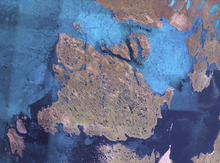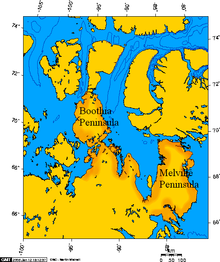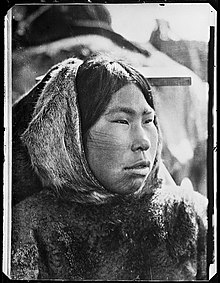Netsilik
Netsilik or more correctly Natsilik Inuit , also Natsilingmiut ( Inuktitut for "residents of the seal town" from "Natsiq", seal), is the name of a smaller Inuit group that lives on the Arctic north coast of Canada on the Boothia peninsula and on King William -Island between the 68th and 70th degree a.d. and the 89th and 95th degree w. L. is at home and now lives in the settlements of Gjoa Haven , Kugaaruk and Taloyoak . According to Rasmussen, their number was 259 in 1923 (150 men and 109 women); Around the year 2000, around 2,400 Inuit lived in the three mentioned settlements.
Their traditional lifestyles are particularly well known, as these were researched by Heinrich Klutschak (1879), Roald Amundsen (1903–1905) and Knud Rasmussen (1920s). Rasmussen realized during his research trip that most of the Natsilik Inuit had never seen a tribe before because of their isolated location. The Natsilik Inuit tribe were the last to give up traditional nomadic life. From 1959 to 1965, the American anthropologist Asen Balikci captured the Natsilik way of life with a film camera. It was observed that in summer they eat insects and meat that has already been decomposed by maggots. Ernie Lyall recorded important details about life in the Taloyoak settlement in his 1979 biography An Arctic Man .
Individual evidence
literature
- Nunavut Handbook, Iqaluit 2004 ISBN 0-9736754-0-3
- Ernie Lyall: An Arctic Man - Sixty-five years in Canada's North . Hurtig, Edmonton 1979. ISBN 0-88780-106-4
Web links
- "The Inuktitut Language" in Project Naming , a project to identify Inuit photographs from the collections of Canadian libraries and archives.



